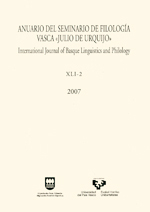Argument structure and morphology: the case of en-prefixation revisited
##plugins.themes.bootstrap3.article.main##
##plugins.themes.bootstrap3.article.sidebar##
Laburpena
In this paper I argue that en-prefixed words in Catalan and English (e.g. amorN 'love' > [[en+amor]V+ar]V 'to make someone fall in love'; nobleA > [en+noble]V are not exceptions to the Right-hand Head Rule (RHR; Williams 1981a). I argue that a Ø-suffix, and not the prefix en-, is responsible for the conversion of adjectives and nouns to verbs (Neeleman & Schipper 1992). The q-grid of N/A-to-V prefixations provides the empirical evidence in favour of the conversion-suffix. The Ø-suffix will be responsible for the presence of a [+c] role and the prefix will account for the [-c-m] features sometimes present in denominal verbs. I will also show that an unaccusative approach (Grimshaw 1990, Sportiche 1998) to reflexives (in Romance) can deal with the data more satisfactorily than an unergative one (Reinhart & Siloni 1999). Finally, a syntactic theory of argument structure (cf. Hale & Keyser 1993, 1998, 2002) will prove not to be sufficient to account for the data.
Nola aipatu
##plugins.themes.bootstrap3.article.details##
Lan hau Creative Commons Aitortu-EzKomertziala-LanEratorririkGabe 4.0 Nazioartekoa lizentzia baten mende dago.


